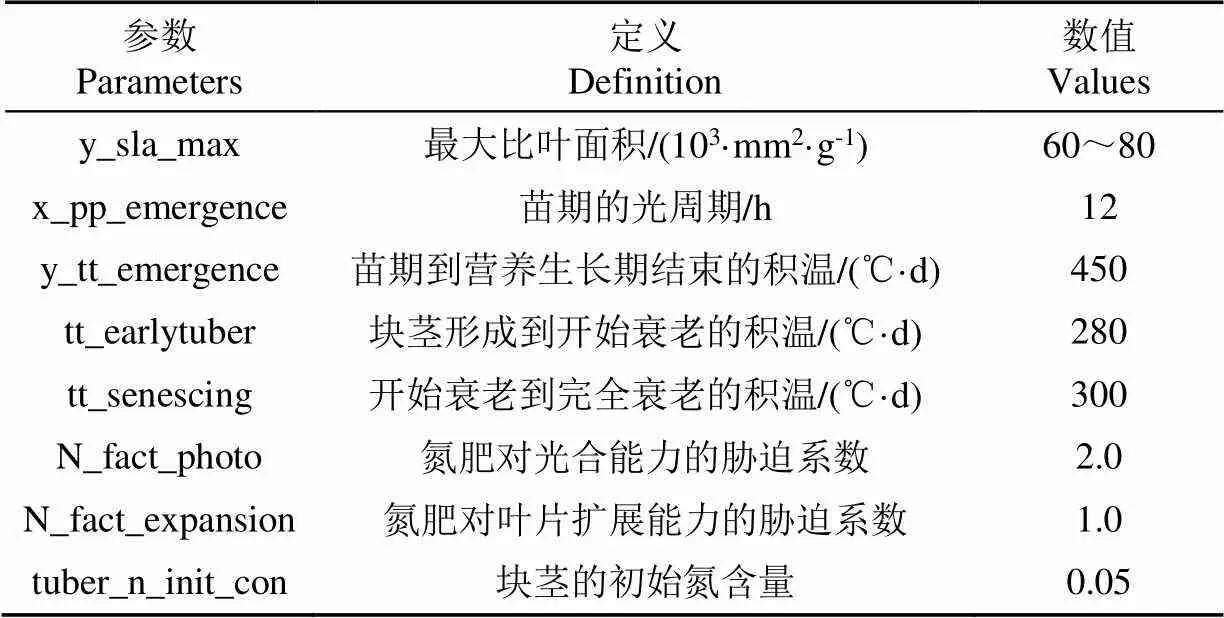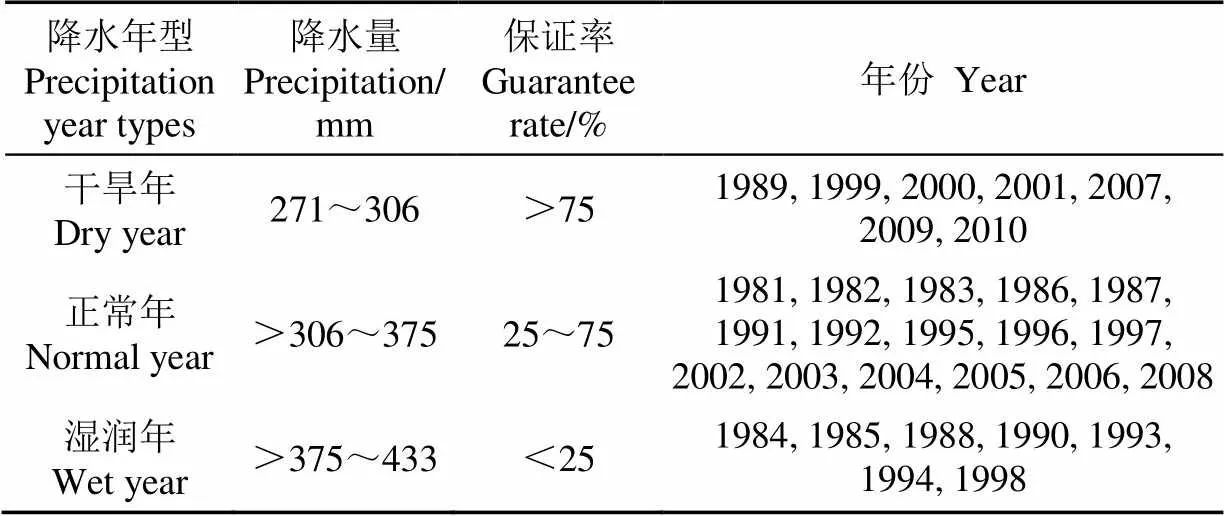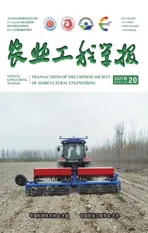不同生产目标条件的马铃薯水氮管理优化
2021-12-29唐建昭肖登攀王仁德柏会子郭风华刘剑锋
唐建昭,肖登攀,王 靖,王仁德,柏会子,郭风华,刘剑锋
不同生产目标条件的马铃薯水氮管理优化
唐建昭1,肖登攀1※,王 靖2,王仁德1,柏会子1,郭风华1,刘剑锋1
(1. 河北省科学院地理科学研究所/河北省地理信息开发应用工程技术研究中心,石家庄 050011;2. 中国农业大学资源与环境学院,北京 100193)
基于不同生产目标,优化不同降水年型下的水氮耦合方案对马铃薯生产的可持续发展具有重要意义。该研究基于中国北方农牧交错带地区27个站点的气象数据、土壤数据和管理数据驱动APSIM-Potato模型,设置不同的灌溉和氮肥耦合情景,基于土壤水分亏缺量设置灌溉情景(共设置10个灌溉梯度,即土壤水分亏缺范围为10~100 mm,间隔10 mm),施氮肥量为30~210 kg/hm2,梯度为30 kg/hm2,模拟分析不同降水年型下水氮耦合对马铃薯产量、水分利用效率和经济收益的影响,并推荐不同降水年型下获得不同生产目标的最佳水氮耦合方案。结果表明:农牧交错带干旱年型、正常年型和湿润年型下不同水氮耦合方案的马铃薯最高产量分别为30 200~39 400、28 900~38 800和27 000~38 000 kg/hm2,其中干旱年型下产量最高。干旱年型、正常年型和湿润年型下获得最高产量的灌溉量分别为589、544和512 mm,氮肥投入量均为最大值,即210 kg/hm2。干旱年型、正常年型和湿润年型下不同水氮耦合方案的马铃薯最高水分利用效率分别为85.9、90.2和92.2 kg/(mm·hm2),获得最高水分利用效率的灌溉量分别为172、107和87 mm,氮肥投入量均在60~120 kg/hm2之间,其中干旱年型下投入量为60 kg/hm2的站点比例最高。干旱年型、正常年型和湿润年型不同水氮耦合方案下马铃薯的最高收益分别为19 340、18 610和18 470元/hm2,获得最高收益的灌溉量分别为226、152和116 mm,干旱年型和正常年型获得最高收益的氮肥投入量均在30~90 kg/hm2之间,湿润年型下获得最高收益的氮肥投入量在60~90 kg/hm2之间。研究结果有助于当地生产者基于不同的生产目标制定较优的水氮管理方案。
灌溉;施肥;产量;水分利用效率;收益
0 引 言
水分是作物生长和产量形成的关键因素,中国农业用水占总用水的63.2%,且主要为灌溉用水[1]。随着灌溉面积和灌溉作物种类的增加,水资源短缺成为农业生产的主要限制因子,严重威胁中国农业的可持续发展[2]。优化灌溉是解决农业水资源短缺的关键措施之一[3]。此外,氮素是作物生长发育的另一重要因素[4]。近三十年来中国氮肥投入总量增长158%,而农作物总产量仅增加70%,氮投入与作物的氮需求不匹配[5]。大量研究表明灌溉和氮肥存在显著的耦合作用,适宜的灌溉量能够提高氮肥利用率,降低氮损失,并且增加作物产量[6-7]。因此,最优施氮方案随着灌溉量的不同而存在差异。
马铃薯是仅次于小麦、玉米和水稻的世界第四大口粮作物[8]。中国是马铃薯生产大国,其生产面积和总产均居世界首位[9]。中国北方农牧交错带气候冷凉,适宜马铃薯生长,是马铃薯主要种植区之一。近几十年来,北方农牧交错带地区马铃薯播种面积和总产量持续增加,占该地区粮食总产的46.8%左右[3]。因此,马铃薯生产对保障北方农牧交错带乃至中国北方地区的粮食安全具有重要意义。
马铃薯对水分变化敏感,短时期干旱胁迫即可导致严重减产[10]。通常,马铃薯需水量在400~800 mm之间[11-12]。北方农牧交错带地区降水量少(≤400 mm)且年际间变异大,大部分年份降水无法满足马铃薯高产和稳产的水分需求,灌溉成为必须措施[10]。然而,长期连续灌溉导致北方农牧交错带地区水资源危机日趋严峻。因此,优化灌溉以达到水分高效利用对该地区马铃薯生产的可持续性具有重要意义。马铃薯灌溉方案的优化主要集中在最佳灌溉时期的选择和灌溉量的确定[13-15],以及灌溉方式的调整[16]。同时,不同的灌溉方案下氮肥的最佳投入量存在显著差异。适宜的水氮组合不仅可以显著提高马铃薯水肥利用效率[17-18],同时,还降低其对环境造成的负面影响[19]。相关研究表明在中等肥力下降低单次灌溉量、增加灌溉频次,马铃薯产量和商品薯率均最高[20]。其中,陕西榆林地区每8 d进行一次充分灌溉、施氮量200 kg/hm2是马铃薯生产的最优水氮组合[21]。
当前,水氮耦合的相关研究主要基于大田试验和统计模型。大田试验需要投入大量的人力、物力和财力,耗时较长[22],而且,试验获得的站点结果难以外推到区域尺度。统计模型虽然在一定程度上比较容易获得作物产量与水氮投入的关系,但整体上机理性较差,需要大量的试验数据进行支撑[23]。基于作物生理生态过程的作物生长机理模型充分考虑气候、土壤和管理对作物生产的耦合影响,在优化作物水氮方面已得到广泛应用[9]。
关于北方农牧交错带地区马铃薯生产的水氮管理已有研究,然而,不同降水年型下针对不同生产目标的最优水氮方案有待揭示。因此,本研究基于作物生长机理模型(APSIM-Potato)模拟不同水氮处理下马铃薯的生产潜力,主要目标为:1)评价不同降水年型下马铃薯产量、水分利用效率和经济收益对不同水氮方案的响应;2) 揭示不同降水年型下获得不同生产目标的最佳水氮耦合方案。
1 材料与方法
1.1 研究区概况与数据来源
本研究选择北方农牧交错带地区(36°08′~50°15′N、104°09′~123°25′E)(图1)作为研究区域。基于气象数据的完整性和有效性共选择27个研究站点。北方农牧交错带地区马铃薯的种植时间在4月底至6月初,当地常规播期为5月10日左右,收获日期一般在9月份第一次霜冻之前[23]。马铃薯生长季总日照时数、平均温度和总降水量分别为1 283 h、15.4 ℃和326 mm。
1981—2010年北方农牧交错带地区27个研究站点气象数据来自中国气象局数据共享网(http://www.cma.gov.cn/),具体数据包括日尺度的最高温度(℃)、最低温度(℃)、降水量(mm)和日照时数(h)。日总太阳辐射根据Angstrom-Prescott方程进行计算[9]。
农牧交错带地区土壤数据来自中国土壤数据库(http://www.soil.csdb.cn/),主要包括土壤容重、凋萎含水量、田间持水量、饱和含水量、土壤养分含量和pH值等土壤理化数据。
1.2 研究方法
1.2.1 马铃薯水氮耦合大田试验
2015年和2016年在农业部武川农业环境科学观测试验站进行不同水氮处理的马铃薯大田试验。供试马铃薯品种为克新一号,生育期110 d左右。播种密度为46 500 株/hm2,播种日期分别为2015年5月2日和2016年5月1日,收获日期分别为2015年9月24日和2016年9月12日。大田试验数据是模型调参验证的基础,同时前人研究表明最有效的模型调参数据是利用差异环境(包括气候、田间处理等)下的观测数据[22]。因此,本研究设置的水氮梯度相对较大。试验采用裂区设计,设置灌溉和氮肥两个因素,灌溉为主处理,氮肥为副处理,试验共设4个灌溉梯度,生育期内灌溉量分别为0、90、180和360 mm,每个灌溉处理下设置4个氮肥梯度,施氮肥梯度分别为0、90、180和360 kg/hm2,共16个处理,每个处理设置4次重复。试验小区采用随机区组排列方式,单个小区面积为30 m2(4 m×7.5 m)。各处理播前磷酸二铵(P2O5,质量分数为46%)和氯化钾(K2O,质量分数为60%)的施入量分别为120和90 kg/hm2,整个生育期不再追施磷肥和钾肥。氮肥40%作基肥,60%按生育期灌水量分配追施。马铃薯生育期分为播种、出苗(2015年为6月16日,2016年为6月26日)、薯块形成(2015年为7月4日,2016年为7月14日)、薯块膨大(2015年为7月20日,2016年为8月3日)和成熟[12],生育期内采用烘干法测定土壤水分。选取中间4行(15m2)进行马铃薯测产。
1.2.2 APSIM-Potato模型及其参数化
APSIM-Potato模型中应用的核心模块主要包括马铃薯模块、土壤水模块、土壤氮模块、土壤有机质模块和管理模块。模型基于辐射、温度、光周期、土壤水和氮肥数据,以日为步长,模拟马铃薯的生长发育、干物质积累和产量形成等。利用2 a田间试验获得的试验数据对APSIM-Potato模型进行校正和验证。模型调参所用的方法为“试错法”。调参年份为2015年,验证年份为2016年。评价APSIM-Potato模型模拟效果的指标包括实测值和模拟值进行线性回归后的决定系数(2),均方根误差(Root Mean Squared Error,RMSE)和相对均方根误差(Normalizedroot Mean Squared Error,NRMSE)。RMSE和NRMSE反映模拟值与实测值之间的绝对误差和相对误差,其值越小,说明模拟值与实测值之间偏差越小,模拟精度越高;2越接近1,表明拟合度越好。经过验证的参数见表1。
1.2.3 模型模拟设置
为充分考虑不同降水年型和气候条件,本文选择1981—2010年作为长期模拟情景,基于验证后的APSIM-Potato模型模拟水氮耦合情景下马铃薯产量、水分利用效率和收益在不同降水年型下的变化,并基于不同生产目标推荐最佳水氮耦合方案。基于土壤水分亏缺(田间持水量与当前土壤含水率的差值)模型启用自动灌溉,土壤水分亏缺范围设置为10~100 mm,间隔10 mm。共设置10个灌溉水平,即土壤水分亏缺量分别为100 mm(IR100)、90 mm(IR90)、……10 mm(IR10)。为比较不同区域之间灌溉投入的差异,以及更好地指导生产实际,本文将计算不同灌溉处理下的具体灌溉量。在每个灌溉水平处理下,设置不同的施氮量,最低施氮量设置为30 kg/hm2,间隔30 kg/hm2逐渐递增,以随着施氮量的增加马铃薯产量不再增加时的施氮量为最大施氮量,本研究中,当施氮量超过210 kg/hm2时马铃薯产量不再增加,因此最大施氮量设置为210 kg/hm2,共设置7个氮肥梯度。

表1 APSIM-Potato模型中使用的马铃薯品种参数
1.2.4 降水年型划分
根据研究区内马铃薯生长季不同等级的降水量(区域内所有站点的平均值)将研究区1981—2010年划分为湿润年、正常年和干旱年[13]。将降水保证率低于25%的年份定义为湿润年份,降水保证率在25%~75%的年份定义为正常年份,降水保证率大于75%的年份定义为干旱年份。具体降水量范围和降水年型如表2所示。

表2 北方农牧交错带地区降水年型的划分
1981—2010年中国北方农牧交错带地区干旱年份、正常年份和湿润年份下的平均降水量分别为289、341和400 mm。基于模型设置的不同灌溉情景模拟计算得出干旱年型、正常年型和湿润年型下不同灌溉处理的平均灌溉量分别为22~634 mm、11~592 mm和8~562 mm。
1.2.5 马铃薯水分利用效率计算方法
马铃薯水分利用效率(Water Use Efficiency,WUE,kg/(mm·hm2))为马铃薯鲜薯产量(Yield,kg/hm2)和蒸散量(ET,mm)的比值,计算公式如下:
WUE=Yield/ET (1)
式中马铃薯蒸散量根据模拟的马铃薯蒸腾量(EP,mm)和土壤蒸发量(ES,mm)求和。
1.2.6 马铃薯生产净收益计算方法
马铃薯生产的净收益根据下式进行计算:
NI=·-Inputs (2)
式中是块茎产量(鲜质量),是马铃薯单价(0.8元/kg),·代表种植马铃薯的总收入。马铃薯生产投入(Inputs)包括种子、灌溉、肥料、除草剂、杀虫剂、翻耕、播种和收获时的机械作业费以及田间劳动的人工费用。各项具体投入为:种子,1.5 元/kg;灌溉,1.2 元/m3;农家肥,1 200 元/hm2;氮肥,5 元/kg;除草剂和杀虫剂,200 元/hm2;翻耕和播种,500 元/hm2;收获,500 元/hm2;人工,500 元/hm2。
2 结果与分析
2.1 APSIM-Potato模型模拟评价
APSIM-Potato模型可以较好地模拟马铃薯的生育期,调参年份和验证年份的RMSE分别为1.7和2.9 d(图 2a和图2b)。APSIM-Potato模型能够较为精准地模拟1 m土层土壤贮水量的变化,调参年份和验证年份的NRMSE分别为13.5%和14.7%(图2c和图2d)。APSIM-Potato模型可以较好地模拟不同水氮处理下马铃薯的氮吸收量,调参年份和验证年份的NRMSE分别为18.3%和22.5%(图2e和图2f)。APSIM-Potato模型能够较好地反映不同水氮组合下的马铃薯产量变化,调参年份和验证年份的NRMSE分别为15.9%和12.2%(图2g和图2h)。
2.2 不同降水年型下马铃薯雨养产量
北方农牧交错带干旱年型、正常年型和湿润年型不施氮肥情景下雨养马铃薯产量分别为4 760~18 500、9 200~20 900和11 900~21 500 kg/hm2(图3)。不同降水年型下马铃薯产量空间分布特征相似,均为东部产量较高。不同降水年型下马铃薯产量保证率差异较大,干旱年型、正常年型和湿润年型保证率为75%的产量水平分别为8 990、11 800和12 000 kg/hm2,保证率为50%的产量水平分别为11 700、15 450和14 800 kg/hm2,保证率为25%的产量水平分别为13 200、17 300和16 800 kg/hm2(图4)。
2.3 不同降水年型下马铃薯最高产量及水氮投入
北方农牧交错带干旱年型、正常年型和湿润年型下不同水氮耦合方案的马铃薯最高产量分别为30 200~39 400 kg/hm2(图5a)、28 900~38 800 kg/hm2(图 5b)和27 000~38 000 kg/hm2(图5c),其中干旱年型下产量最高,湿润年型下产量最低。干旱年型下马铃薯产量东部和西部较高(图5a),正常年型和湿润年型下西部产量最高(图5b和图5c)。三种年型下获得最高产量的氮肥投入均是最大值,为210 kg/hm2(图5未展示)。北方农牧交错带干旱年型、正常年型和湿润年型下获得最高产量的灌溉量分别为301~1 080 mm(图 5d)、256~1 050 mm(图5e)和211~1 030 mm(图5f),区域平均分别为589、544和512 mm。三种降水年型下,灌溉投入均呈东部和西部较高、中部较低。
2.4 不同降水年型下马铃薯最高水分利用效率及水氮投入
北方农牧交错带干旱年型、正常年型和湿润年型下不同水氮耦合方案的马铃薯最高水分利用效率分别为64.6~104.9 kg/(mm·hm2)(图6a)、68.8~109.2 kg/(mm·hm2)(图 6b)和70.8~113.0 kg/(mm·hm2)(图6c),区域平均值分别为85.9、90.2和92.2 kg/(mm·hm2)。不同降水年型下均是西部水分利用效率较高。干旱年型、正常年型和湿润年型下获得最高水分利用效率的灌溉量分别为57~334(图6d)、28~243(图6e)和21~240 mm(图6f),整体上干旱年型下灌溉量最高,为172 mm,正常年型和湿润年型下分别为107和87 mm。区域分布上,干旱年型下中部较高,正常年型和湿润年型下西部较高。不同降水年型下,获得最高WUE的氮肥投入量为60~120 kg/hm2,干旱年型下氮肥投入量为60、90和120 kg/hm2的站点数分别占站点总数的63.0%、29.6%和7.4%(图6g);正常年型下分别为33.3%、55.6%和11.1%(图6h);湿润年型下分别为14.8%、66.7%和18.5%(图 6i)。
2.5 不同降水年型下马铃薯最高收入及水氮投入
北方农牧交错带干旱年型、正常年型和湿润年型下不同水氮耦合方案的马铃薯的最高收益分别为11 440~23 890(图7a)、12 330~23 520(图7b)和11 950~23 670 元/hm2(图7c),区域平均值分别为19 340、18 610和18 470元/hm2。三种年型下均是中西部收益最高。干旱年型、正常年型和湿润年型下获得最高收益的灌溉量分别为114~517 mm(图7d)、76~413 mm(图7e)和25~265 mm(图7f),区域平均值分别为226、152和116 mm,不同降水年型下均是东部灌溉量较高。干旱年型和正常年型下获得最高收益的氮肥投入量均在30~90 kg/hm2之间,湿润年型下获得最高收益的氮肥投入量在60~90 kg/hm2之间(图7i)。干旱年型下,氮肥投入量为30、60和90 kg/hm2的站点数分别占总站点数的37.0%、37.0%和26.0%(图7g);正常年型下分别为11.2%、44.4%和44.4%(图7h);湿润年型下51.9%的站点氮肥投入量为60 kg/hm2,其余站点皆为90 kg/hm2(图7i)。
3 讨 论
农牧交错带地区降水年际变率大,不同年份降水量及其季节分布是马铃薯土壤蓄墒和增产的关键因素[9],分析不同降水年型下的最佳水氮耦合方案,有助于建立绿色高效的马铃薯生产体系。本研究首先分析了不同降水年型下马铃薯的雨养产量,结果表明干旱年型下马铃薯产量(11 300 kg/hm2)低于正常年型(15 100 kg/hm2)和湿润年型下马铃薯产量(14 900 kg/hm2)。通常,作物产量随着降水量的增加而增加[24],干旱年型下马铃薯生长季降水量低于正常年型和湿润年型,因此马铃薯无法获得较高的产量。在一些湿润年份,降水有效性低,并且随着无效降水频次的增加,生长季辐射降低[8,10],因此湿润年型产量略低于正常年型。
水和肥(尤其氮肥)是影响马铃薯生长的两个重要因子,协调灌溉量和施氮量使其关系达到最优,是实现马铃薯高产增收的关键[18]。本研究推荐了不同年型下马铃薯生产获得不同目标的最佳水氮耦合方案。不同水氮组合下,农牧交错带干旱、正常和湿润年型下马铃薯最高产量分别为35 600、34 000和33 100 kg/hm2。灌溉条件下,水分不是马铃薯产量的限制因子[9]。不同降水年型下马铃薯生长季内总辐射差异较大,正常和湿润年型下,降水频次较高导致马铃薯生长季内总辐射低于干旱年型,因此干旱年型下马铃薯产量高于正常和湿润年型。三种年型下马铃薯获得最高产量的氮肥投入量均为210 kg/hm2,前人通过大田试验研究结果表明该地区马铃薯获得最高产的适宜施氮量为225 kg/hm2[25],本文研究结果与前人基本一致。干旱年型、正常年型和湿润年型下获得最高产量的灌溉量分别为589、544和512 mm,前人研究结果表明农牧交错带地区马铃薯获得高产需要的灌水量在450~550 mm之间[26],与本研究较为一致。然而,片面追求高产不利于该地区农业的可持续发展[14]。
提升马铃薯水分利用效率是保证高产、降低生产成本和减少环境负面影响的关键[27-28]。本研究表明干旱年型、正常年型和湿润年型下马铃薯水分利用效率分别为85.9、90.2和92.2 kg/(mm·hm2)。前人研究表明湿润年型下马铃薯在雨养条件下水分利用效率高于干旱年型下[29]。本研究为灌溉条件,得出同样的结论。通过进一步分析马铃薯生育期内作物蒸腾和土壤蒸发的比例,发现随着降水量的增加作物蒸腾比例上升,土壤无效蒸发降低,同时干旱年型下灌溉量投入大于湿润年型,灌溉量减少进一步提升蒸腾比重,因此湿润年型下水分利用效率高于其他年型。本研究表明获得马铃薯最高水分利用效率,农牧交错带地区干旱年型、正常年型和湿润年型的灌溉量分别为172、107和87 mm,氮肥投入量在60~120 kg/hm2之间,远低于获得最高产量的投入量,与前人研究结果一致[16,18]。
产量和生产投入共同决定种植马铃薯的经济收益[30]。本研究表明北方农牧交错带干旱年型、正常年型和湿润年型下不同水氮耦合方案的马铃薯的最高经济收益分别为19 340、18 610和18 470元/hm2。前人研究表明种植马铃薯的纯收益在23 000~35 000元/hm2之间[18],高于本研究,主要由对块茎价格及投入估计的差别导致。干旱年型、正常年型和湿润年型下种植马铃薯获得最高经济收益的灌溉投入分别为226、152和116 mm,氮肥投入量在30~90 kg/hm2之间。前人基于大田试验研究表明马铃薯种植获得最高经济收益的水氮投入分别为300 mm和200 kg/hm2[18]。前人推荐的水氮投入量高于本研究,主要因为模型模拟情景是在理想条件下,而实际灌溉过程中由于相对粗放的灌溉管理方式会产生水分的散失[31-32];在施肥方面,由于实际生产过程中氮肥施用方式的差异(表面施肥或根际施肥),APSIM-Potato模型可能会低估氮损失的量[33-34]。然而,本研究结果仍然对生产实际具有重要的指导意义,尤其是田间管理条件良好的农田。
获得不同生产目标的水氮投入量不同,其中获得最高产量的水氮投入量远高于获得其他目标的水氮投入量。主要是因为马铃薯对水氮较为敏感[28],在一定范围内,随着水氮投入量的增加,马铃薯产量持续增加,本研究中马铃薯最高产量指马铃薯产量不再随着水氮投入量增加时获得的产量,因此水氮投入量较高。而获得其他生产目标如最高收益,受到投入和产量的共同限制,水氮投入超过一定量后,投入产出比降低造成收益降低。因此,获得不同生产目标的水氮投入量差异较大。
本研究仍存在一些不足:1)马铃薯总收入主要取决于商品薯产量,然而APSIM-Potato模型不具备模拟商品薯产量的能力,研究结果可能会略微高估马铃薯生产的实际收益,下一步应改进模型的机理性,使其具备模拟商品薯产量的能力;2)本研究中只应用了单一作物模型,模拟结果存在一定的不确定性,下一步研究应结合更多的作物模型如LINTUL-POTATO模型和DSSAT模型开展模型对比研究;3)APSIM-Potato模型的调参验证(如多参同效)会给结果带来一定的不确定性,但本研究结果仍然可为马铃薯生产提供重要的指导意义;4)APSIM-Potato未充分考虑病虫害对马铃薯生产的影响,可能会高估不同水氮处理下的产量。
4 结 论
作物生长模型是针对不同生产目标优化农业管理措施的有效工具。本研究基于充分验证的APSIM-Potato模型,设置不同灌溉和氮肥的耦合情景,模拟分析了不同降水年型下水氮耦合对马铃薯产量、水分利用效率和经济收益的影响,并推荐了不同降水年型下获得不同生产目标的最佳水氮管理方案。主要结论如下:
1)干旱年型下雨养马铃薯产量为4 760~18 500 kg/hm2,低于正常年型(9 200~20 900 kg/hm2)和湿润年型(11 900~21 500 kg/hm2),不同降水年型马铃薯产量空间分布特征相似,均为中部产量低于东部和西部。
2)不同水氮耦合方案获得的最高产量,干旱年型下马铃薯产量高于正常年型和湿润年型。获得最高产量,干旱年型下灌溉量最高,为589 mm,正常年型和湿润年型下的投入量分别为544和512 mm,不同降水年型下的氮肥投入量均为最大量,即210 kg/hm2。
3)不同水氮耦合方案获得的最高水分利用效率,湿润年型下马铃薯水分利用效率最高,干旱年型下最低。获得最高水分利用效率,干旱年型下灌溉量最高,为172 mm,正常年型和湿润年型分别为107和87 mm,三种年型下氮肥投入量均在60~120kg/hm2之间。
4)不同水氮耦合方案下获得的最高经济收益,干旱年型下最高,灌溉量也最高,为226 mm,正常年型和湿润年型下的灌溉量分别为152和116 mm,干旱年型下氮肥投入量均在30~90 kg/hm2之间,湿润年型下均在60~90 kg/hm2之间。
[1] 王玉宝,吴普特,赵西宁,等. 我国农业用水结构演变态势分析[J]. 中国生态农业学报,2010,18(2):399-404.
Wang Yubao, Wu Pute, Zhao Xining, et al. Development tendency of agricultural water structure in China[J]. Chinese Journal of Eco-Agriculture, 2010, 18(2): 399-404. (in Chinese with English abstract)
[2] 操信春,刘喆,吴梦洋,等. 水足迹分析中国耕地水资源短缺时空格局及驱动机制[J]. 农业工程学报,2019,35(18):94-100.
Cao Xinchun, Liu Zhe, Wu Mengyang, et al. Temporal-spatial distribution and driving mechanism of arable land water scarcity index in China from water footprint perspective[J]. Transactions of the Chinese Society of Agricultural Engineering (Transactions of the CSAE), 2019, 35(18): 94-100. (in Chinese with English abstract)
[3] Tang J Z, Xiao D P, Wang J, et al. Optimizing water and nitrogen managements for potato production in the agro-pastoral ecotone in North China[J]. Agricultural Water Management, 2021, 253: 106945.
[4] 刘钦普,濮励杰. 中国粮食主产区化肥施用时空特征及生态经济合理性分析[J]. 农业工程学报,2019,35(23):142-150.
Liu Qinpu, Pu Lijie. Spatiotemporal variation of fertilizer utilization and its eco-economic rationality in major grain production areas of China[J]. Transactions of the Chinese Society of Agricultural Engineering (Transactions of the CSAE), 2019, 35(23): 142-150. (in Chinese with English abstract)
[5] Cui Z L, Chen X P, Zhang F S, et al. Development of regional nitrogen rate guidelines for intensive cropping systems in China[J]. Agronomy Journal, 2013, 105: 1141-1146.
[6] 吉艳芝,徐明杰,巨晓棠,等. 华北平原不同种植制度对粮食作物氮素利用和土壤氮库的影响[J]. 农业工程学报,2020,36(19):86-96.
Ji Yanzhi , Xu Mingjie, Ju Xiaotang, et al. Effects of different cropping systems on food crop nitrogen utilization and soil nitrogen pool in North China Plain[J]. Transactions of the Chinese Society of Agricultural Engineering (Transactions of the CSAE), 2020, 36(19): 86-96. (in Chinese with English abstract)
[7] 李如楠,李玉娥,王斌,等. 双季稻减排增收的水氮优化管理模式筛选[J]. 农业工程学报,2020,36(21):105-113.
Li Runan, Li Yu’e, Wang Bin, et al. Pattern selection of water and nitrogen practices to reduce greenhouse gas emission and increase profit in a double rice system[J]. Transactions of the Chinese Society of Agricultural Engineering (Transactions of the CSAE), 2020, 36(21): 105-113. (in Chinese with English abstract)
[8] Tang J Z, Wang J, Fang Q X, et al. Optimizing planting date and supplemental irrigation for potato across the agro-pastoral ecotone in North China[J]. European Journal of Agronomy, 2018, 98: 82-94.
[9] 唐建昭. 北方农牧交错带马铃薯基于缩差和增效的种植管理模式研究[D]. 北京:中国农业大学,2018.
Tang Jianzhao. A Study on Planting Pattern of Potato to Narrow Yield Gap and Increase Precipitation Use Efficiency in the Agro-Pastoral Ecotone in North China[D]. Beijing: China Agricultural University, 2018. (in Chinese with English abstract)
[10] Tang J Z, Wang J, Fang Q X, et al. Identifying agronomic options for better potato production and conserving water resources in the agro-pastoral ecotone in North China[J]. Agricultural and Forest Meteorology, 2019, 272/273: 91-101.
[11] Tang J Z, Wang J, Wang E L, et al. Identifying key meteorological factors to yield variation of potato and the optimal planting date in the agro-pastoral ecotone in North China[J]. Agricultural and Forest Meteorology, 2018, 256/257: 283-291.
[12] Haverkort A J, Van de Waart M, Bodlaeader K B A. The effects of early drought stress on numbers of tuber and stolons of potato in controlled and filed conditions[J]. Potato Research, 1990, 33(1): 89-96.
[13] Liu F L, Shahnazari A, Andersen M. Effects of deficit irrigation and partial root drying on gas exchange, biomass partitioning and water use efficiency in potato[J]. Scientia Horticulturae, 2006, 109: 113-117.
[14] 张朝巍,董博,郭天文,等. 补充灌溉对半干旱区马铃薯产量和水分利用效率的影响[J]. 水土保持通报,2011,31(5):49-53.
Zhang Chaowei, Dong Bo, Guo Tianwen, et al. Effects of supplementary irrigation on potato yield and water use efficiency in semi-arid area of Gansu Province[J]. Bulletin of Soil and Water Conservation, 2011, 31(5): 49-53. (in Chinese with English abstract)
[15] 谢开云,王晓雪,张若芳,等. 隔沟交替灌溉对我国半干旱地区马铃薯水分利用的影响[J]. 中国马铃薯,2012,26(1):5-10.
Xie Kaiyun, Wang Xiaoxue, Zhang Ruofang, et al. Effect of partial root-zone drying on potato water utilization on semi-arid conditions in China[J]. Chinese Potato Journal, 2012, 26(1): 5-10. (in Chinese with English abstract)
[16] 秦永林,井涛,康文钦,等. 阴山北麓马铃薯在不同灌溉模式下的水肥效率[J]. 中国生态农业学报,2013,21(4):426-431.
Qin Yonglin, Jing Tao, Kang Wenqin, et al. Water and fertilizer use efficiency of potato under different irrigation patterns in North Yin Mountain Region[J]. Chinese Journal of Eco-Agriculture, 2013, 21(4): 426-431. (in Chinese with English abstract)
[17] 秦永林,于静,陈杨,等. 内蒙古灌溉马铃薯施肥现状及肥料利用效率[J]. 中国蔬菜,2019,11:75-79.
Qin Yonglin, Yu Jing, Chen Yang, et al. Situation of fertilization and fertilizer use efficiency on irrigated potato in Inner Mongolia[J]. China Vegetables, 2019, 11: 75-79. (in Chinese with English abstract)
[18] Wang H D, Wang X K, Bi L F, et al. Multi-objective optimization of water and fertilizer management for potato production in sandy areas of northern China based on TOPSIS[J]. Field Crops Research, 2019, 240: 55-68.
[19] Karam F, Amacha N, Fahed S, et al. Response of potato to full and deficit irrigation under semiarid climate: agronomic and economic implications[J]. Agricultural Water Management, 2014, 142, 144-151.
[20] 何华,陈国良,赵世伟. 水肥配合对马铃薯水分利用效率的影响[J]. 干旱地区农业研究,1999,17(2):59-66.
He Hua, Chen Guoliang, Zhao Shiwei. Effect of different water and fertilizer conditions on water use efficiency of potato[J]. Agricultural Research in the Arid Areas, 1999, 17(2): 59-66. (in Chinese with English abstract)
[21] 张富仓,高月,焦婉如,等. 水肥供应对榆林沙土马铃薯生长和水肥利用效率的影响[J]. 农业机械学报,2017,48(3):270-278.
Zhang Fucang, Gao Yue, Jiao Wanru, et al. Effects of water and fertilizer supply on growth, water and nutrient use efficiencies of potato in sandy soil of Yulin Area[J]. Transactions of the Chinese Society for Agricultural Machinery, 2017, 48(3): 270-278. (in Chinese with English abstract)
[22] He D, Wang E L, Wang J, et al. Data requirement for effective calibration of process-based crop models[J]. Agricultural and Forest Meteorology, 2017, 234: 136-148.
[23] Tang J Z, Wang J, He D, et al. Comparison of the impacts of climate change on potential productivity of different staple crops in the agro-pastoral ecotone of North China[J]. Journal of Meteorological Research, 2016, 30(6): 983-997.
[24] Stewart B A, Peterson G A. Managing green water in dryland agriculture[J]. Agronomy Journal, 2015, 107(4): 1544-1553.
[25] 李瑞,樊明寿,郑海春,等. 基于产量水平的内蒙古阴山地区马铃薯施肥评价[J]. 中国土壤与肥料,2020(6):181-188.
Li Rui, Fan Mingshou, Zheng Haichun, et al. Evaluation of potato fertilization based on yield level in Yinshan Region of Inner Mongolia[J]. Soil and Fertilizer Sciences in China, 2020(6): 181-188. (in Chinese with English abstract)
[26] 胡琦,潘学标,邵长秀,等. 内蒙古降水量分布及其对马铃薯灌溉需水量的影响[J]. 中国农业气象,2013,34(4):419-424.
Hu Qi, Pan Xuebiao, Shao Changxiu, et al. Distribution of precipitation in Inner Mongolia and its impact on potato irrigation amount[J]. Chinese Journal of Agrometeorology, 2013, 34(4): 419-424. (in Chinese with English abstract)
[27] Onder S, Galiskan M E, Onder D, et al. Different irrigation methods and water stress effects on potato yield and yield components[J]. Agricultural Water Management, 2005, 73(1): 73-86.
[28] Badr M A, El-Tohamy W A, Zaghloul A M. Yield and water use efficiency of potato grown under different irrigation and nitrogen levels in an arid region[J]. Agricultural Water Management, 2012, 110: 9-15.
[29] 张璐阳,潘志华,孙彦坤. 不同降水年型对马铃薯水分利用效率及水分生产潜力开发的影响-以武川县为例[J]. 中国马铃薯,2013,27(2):65-71.
Zhang Luyang, Pan Zhihua, Sun Yankun. Effects on water use efficiency of potato and development of water potential productivity in different precipitation years: A case of Wuchuancounty[J]. Chinese Potato Journal, 2013, 27(2): 65-71. (in Chinese with English abstract)
[30] Woli P, Hoogenboom G, Alva A. Simulation of potato yield, nitrate leaching, and profit margins as influenced by irrigation and nitrogen management in different soil and production regions[J]. Agricultural Water Management, 2016, 171, 120-130.
[31] 崔远来,董斌,李远华,等. 农业灌溉节水评价指标与尺度问题[J]. 农业工程学报,2007,23(7):1-7.
Cui Yuanlai, Dong Bin, Li Yuanhua, et al. Assessment indicators and scales of water saving in agricultural irrigation[J]. Transactions of the Chinese Society of Agricultural Engineering (Transactions of the CSAE), 2007, 23(7): 1-7. (in Chinese with English abstract)
[32] 唐建昭,肖登攀,柏会子. 未来气候情境下农牧交错带不同灌溉水平马铃薯产量和水分利用效率[J]. 农业工程学报,2020,36(2):103-112.
Tang Jianzhao, Xiao Ddengpan, Bai Huizi. Yield and water use efficiency of potato under different irrigation levels in future climate change[J]. Transactions of the Chinese Society of Agricultural Engineering (Transactions of the CSAE), 2020, 36(2), 103-112. (in Chinese with English abstract)
[33] 王敬国,林杉,李保国. 氮循环与中国农业氮管理[J]. 中国农业科学,2016,49(3):503-517.
Wang Jingguo, Lin Shan, Li Baoguo. Nitrogen cycling and management strategies in Chinese agriculture[J]. Scientia Agricultura Sinica, 2006, 49(3): 503-517. (in Chinese with English abstract)
[34] 唐建昭,王靖,肖登攀,等. 马铃薯生长模型的研究进展及发展前景[J]. 中国农业科学,2021,54(5):921-932.
Tang Jianzhao, Wang Jing, Xiao Dengpan, et al. Research progress and development prospect of potato growth model[J]. Scientia Agricultura Sinica, 2021, 54(5): 921-932. (in Chinese with English abstract)
Optimizing irrigation and nitrogen management for potato production under multi-objective production conditions
Tang Jianzhao1, Xiao Dengpan1※, Wang Jing2, Wang Rende1, Bai Huizi1, Guo Fenghua1, Liu Jianfeng1
(1.,,,,050011,;2.,,100193,)
Water is a determining factor in crop production, particularly with the increase of irrigation areas and crops in recent years. Water shortage has posed a great challenge to crop production in North China. Fortunately, the nitrogen (N) fertilizer can serve as another key factor for crop growth and yield formation. However, there is a severe unbalance between the supply of N fertilizer and crop demand. It is also a trade-off between the irrigation and N fertilizer in most parts of Agro-Pastoral Ecotone (APE), which is one of the staple production regions for potatoes in China. Therefore, it is necessary to optimize the irrigation and N management for potato sustainable production using various production goals under different precipitation years. In this study, 27 study sites in the APE were selected to explore the coupling impacts of irrigation and N on the potato yield, Water Use Efficiency (WUE), and economic benefits using the Agricultural Production Systems Simulator (APSIM) Potato model. A two-year field experiment was also carried out under different treatments of irrigation and N fertilizer at a typical site in the APE. Specifically, ten irrigation levels were set in the test, where the deficit values ranged from 10 to 100 mm with the interval of 10 mm, while the application amount of N fertilizer ranged from 30 to 210 kg/hm2with the interval of 30 kg/hm2. Three types of precipitation years (dry, normal, and wet) were divided in the APE, according to the guarantee rate of precipitation. Subsequently, the WUE was calculated using the ratio of fresh potato yield to evapotranspiration. The economic benefit was the difference between the gross income and the total inputs, where the gross income was the product of the total fresh yield and unit price. Among them, the inputs included the cost of seeding, irrigation, fertilization, use of fungicides and pesticides, tillage, planting and harvesting, and labor. The results showed that the APSIM-Potato model performed well to simulate the phenology, the soil water content of 1m depth, potato N uptake, and yield. The yield of rainfed potato without the application of N fertilizer was ranged from 4 760 to 18 500 kg/hm2, from 9 200 to 20 900 kg/hm2, and from 11 900 to 21 500 kg/hm2under dry, normal and wet precipitation years, respectively. More importantly, the yields were the lowest in the middle APE under all types of precipitation years. The maximum yield of potato was achieved under the dry year using different combinations of irrigation and N fertilizer. In addition, an optimal combination was achieved to maximize the yield, where the irrigation inputs were 589, 544, and 512 mm in dry, normal, and wet years, respectively, while the N application amounts were all 210 kg/hm2. The irrigation inputs were much higher in the eastern and western APE under all precipitation year types. The maximum WUEs were 85.9, 90.2, and 92.2 kg/ (mm·hm2) in the dry, normal, and wet years, respectively. An optimal combination was also achieved to maximize the WUE, where the irrigation inputs were 172, 107, and 87 mm in the dry, normal, and wet years, respectively, while the amounts of N were 60-120 kg/hm2. Among them, the proportion of sites with 60 kg/hm2was the highest in the dry years. As such, the maximum economic benefits were 19 340, 18 610, and 18 470 Yuan/hm2in dry, normal, and wet years, respectively. An optimal combination was also achieved to maximize the income, where the irrigation inputs were 226, 152, and 116 mm in dry, normal, and wet years, respectively, while the application amounts of N were 30-90 kg/hm2in different year types. The proportion of sites with 90 kg/hm2was the highest in the wet years. The finding can greatly contribute to formulating optimal management of irrigation and N fertilizer, according to various goals of potato production under different precipitation years.
irrigation; fertilization; yield; water use efficiency; income
唐建昭,肖登攀,王靖,等. 不同生产目标条件的马铃薯水氮管理优化[J]. 农业工程学报,2021,37(20):108-116.doi:10.11975/j.issn.1002-6819.2021.20.012 http://www.tcsae.org
Tang Jianzhao, Xiao Dengpan, Wang Jing, et al. Optimizing irrigation and nitrogen management for potato production under multi-objective production conditions[J]. Transactions of the Chinese Society of Agricultural Engineering (Transactions of the CSAE), 2021, 37(20): 108-116. (in Chinese with English abstract) doi:10.11975/j.issn.1002-6819.2021.20.012 http://www.tcsae.org
2021-07-16
2021-10-11
河北省自然科学基金项目(C2021302004);河北省科学院科技计划项目(21114);河北省科学院重点学科项目(491-0401-YBN-DDH4)
唐建昭,博士,副研究员,研究方向为作物系统模拟。Email:tjzcau@163.com
肖登攀,博士,研究员,研究方向为农业生态。Email:xiaodengpan168@163.com
10.11975/j.issn.1002-6819.2021.20.012
S162.3
A
1002-6819(2021)-20-0108-09
